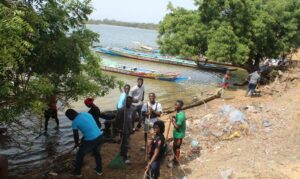Community-Based Climate Change Mitigation and Adaptation Program (PCA.2C project) – Phase 2
Number of beneficiaries: 18,200 people
Project duration: 2025/2030, 5 years
Location: Senegal, Fatick region, Fimela

Local Partner
Youth and Development (JED) / Scouts and Girl Scouts of Senegal (EEDS) is a development NGO created in 1936, and established in all regions of Senegal, inspired by Scout values, serving young people and the community. Its mission is to contribute to the improvement of the quality of life of the populations, mainly in the field of health, education, socio-economic integration and the environment, by preparing young people in particular for their role of active and responsible citizens in synergy with the Girl Scouts and Scouts of Senegal. Its areas of intervention are:
- youth education,
- the health,
- citizen participation,
- the living environment of vulnerable groups,
- the protection of the environment,
- hygiene, water and sanitation,
- training and microcredit.
Context
In Senegal, the impacts of climate change pose serious risks to agriculture, water resources, and coastal areas (CPDN, 2015).
The Fimela district is rich in land, forest, water, fisheries, and other resources.
The district is experiencing a high rate of deforestation, which threatens the vegetation cover, particularly the mangroves, which cover approximately 30% of the area and help preserve and develop fisheries resources. This deforestation is due to human pressure and changing climatic conditions (a vicious circle). The increasingly pressing need for arable land and residential sites, and the search for wood for construction and heating, contribute to environmental degradation. Furthermore, the encroachment of the salt marsh and the development of tourist facilities are reducing the vegetation cover.
We are therefore in a context of resource degradation and the strengthening of innovative and sustainable environmental initiatives to mitigate the negative impacts of climate change.
This phase 2 of the PCA.2C is designed to address, as in phase 1, the adaptation priorities identified in Senegal’s revised INDC (2021), by strengthening and expanding environmental education, ecological monitoring, and resource management in protected areas, among other areas.
These priorities include:
-Sustainable management of fisheries resources;
-Promoting the development of sustainable aquaculture;
-Improving the safety of fishing communities and fisheries-related infrastructure;
-Restoration and sustainable management of mangroves;
-Reclamation of salt-affected lands;
-Use of adapted varieties;
-Strengthening community resilience through the promotion of climate-smart agricultural practices and technologies (including fisheries and livestock) (adapted varieties, fertilization, agroforestry), the construction of defensive structures and soil restoration, aquaculture, pastoral land restoration, and the diversification of production systems (improving food and nutritional security, etc.).
Activities
The project’s activities revolve around four components, namely:
-(1) Ecosystem protection and restoration. This activity remains a key component and must complement the other program components.
-(2) Promoting nature-based solutions. Combating salinity and improving farming techniques and incomes can only be achieved through this synergistic process initiated with the PCA.2C. These stakeholders include academics, local decision-makers, community leaders, supervisors, children, etc. Their power and collaboration will be decisive in the proposed program.
-(3) Environmental awareness and advocacy. This component reinforces the first two components to achieve behavioral change and influence environmental decision-making at both the local and national levels.
-(4) Monitoring and capitalizing on results. Indeed, it will certainly be necessary to work at the grassroots level with communities, but it is essential to disseminate successes for the dissemination of good practices and the commitment of pastoral land decision-makers and the diversification of production systems (improving food and nutritional security, etc.).
Beneficiaries
The project will reach 18,200 men and women resource users: farmers, fishermen, fishery product processors, traditional healers, livestock breeders, wood craftsmen, beekeepers, hunters, hoteliers, and residents.
Specifically:
-50 young people from community organizations
-50 women leaders
-50 community stakeholders (religious, traditional, administrative leaders, etc.)
-50 municipal councilors
-20 teachers
-1000 (students, scouts, talibé children, etc.)
-17000 young men and women.
These beneficiaries will differ from the first phase, as the second phase of the project aims to build on existing achievements and diversify stakeholders to contribute to the resilience of the entire community to the effects of climate change.
